This blog post was written by Brady Watson, former Civic Engagement Coordinator for the Southern Alliance for Clean Energy.
On July 14, the Knoxville Mayor’s Climate Council convened for its second meeting to discuss transportation-related strategies to reduce greenhouse gas emissions. The purpose of the Climate Council is to develop a plan to help the city meet its goal of reducing carbon emissions by 80% community-wide by 2050. Watch the recording and read a recap from the first meeting.

Equity Committee Guides Group
At the top of the meeting agenda, there was a recap from the Equity Committee, established to ensure the strategies identified in the technical working groups are viewed through an equity lens. The Southern Alliance for Clean Energy (SACE) was part of a coalition of groups that called for an equity component as part of the Climate Council. With members including:
- Kendra Berry, Great Schools Partnership
- Claudia Caballero, Centro Hispano de East Tennessee
- Terrence Carter, Knoxville Area Urban League
- Misty Goodwin, Knox CAC – Neighborhood Centers
- Rick Held, Community Voices
- JD Jackson, Socially Equal Energy Efficient Development (SEEED)
- Stanley Johnson, Socially Equal Energy Efficient Development (SEEED)
- Dave Ndiaye, University of Tennessee – Student Disability Services
- Albert Nelson, Knox CAC – Neighborhood Centers
- Janea Peterson, Knoxville Area Urban League
- June Rosten, AFL-CIO
- Reverend Calvin Taylor Skinner, NAACP
Erin Rose, the Equity Committee chair, laid out elements of a possible equity framework that will be used throughout the Climate Council planning process. Erin identified equity elements that will be weighed, including:
- Social and cultural justice
- Economic and distributive justice
- Environmental justice
- Party in participation, and
- Legal protections and provisions
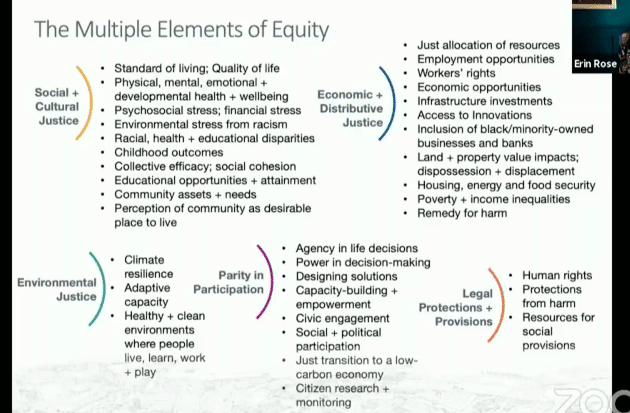
For next steps, the Equity Committee has identified the need to:
- Refine the definition of equity within the context of climate planning and action
- Establish goals and equity principles for guiding the committee’s work
- Select frameworks and equity ‘lenses’ for identifying and considering ‘frontline’ communities; both spatially and temporally
- Engage with communities and groups to better understand lived experiences and the importance of targeted sectors
- Develop screening questions for proposed climate action strategies
- Agree upon evaluation criteria and scoring approach for judging proposed climate strategies
Technical Presentations from EV Experts in Transportation Sector
Encourage EV Adoption with more Infrastructure in Diverse Communities
Kent Minault with the Harvey Broome Group of Sierra Club presented on electric vehicle (EV) adoption. Minault started by explaining that incentives are an important method to increase EV adoption. These can be offered by the auto manufacturers, local utility companies, or even municipalities.
One barrier to EV adoption Minault mentioned is the lack of charging infrastructure, particularly in low-income and minority areas. He cited the fact that charging locations in Knoxville are concentrated mainly in West Knoxville, a mostly white, wealthy part of town, in contrast to East Knoxville, a more racially diverse and low-income part of town, which has no charging stations.
One way to remedy this issue, according to Minault, is to use the newly installed LED lights around the city as charging locations. This has been done in other cities around the U.S., and according to Minault, would be a great potential opportunity to close some of the disparities in charging infrastructure and make EV charging more accessible to the very people who will benefit from it the most.
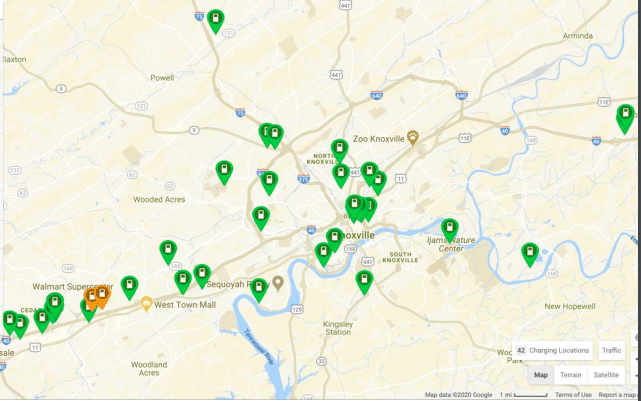
Fuel Efficiency Leads to Large Savings
According to David Greene from the University of Tennessee Knoxville (UTK), the first step in making progress to increase fuel efficiency is building a broad public consensus. After that, the most important action is increasing energy efficiency across all sectors, including transportation. As you can see from the chart below, over two trillion dollars have been saved from 1975-2018 as a result of fuel economy improvements in U.S. light-duty vehicles.
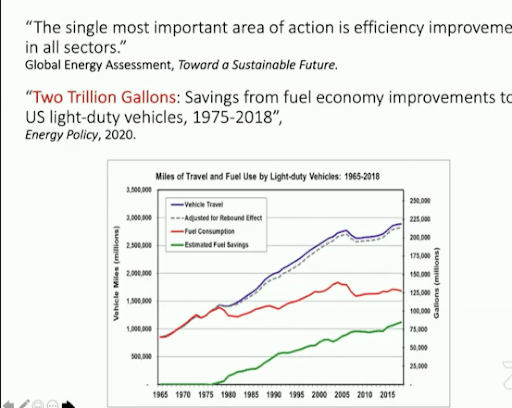
Additionally, Green noted savings from increased fuel efficiency are increasingly greater than the initial cost of newer, more efficient vehicles.
Relationship between city vehicle fleets and greenhouse gas reductions
Jonathan Overly with East Tennessee Clean Fuels coalition presented on the relationship between city vehicle fleets and greenhouse gas reductions. His recommendation was to develop a plan to advance plug-in EV adoption and use.
The conversation then shifted to transit and transportation demand management, starting with Chris Cherry from UTK, who began by reiterating that reductions in transportation emissions will be absolutely essential in reducing overall greenhouse gas emissions. The chart below shows that the population of the Knoxville metro area is growing, as is per capita travel demand. The negative impacts of these increases in population and travel demand outnumber and outweigh the positive impacts of the decreasing emissions from the electric grid and personal vehicles.
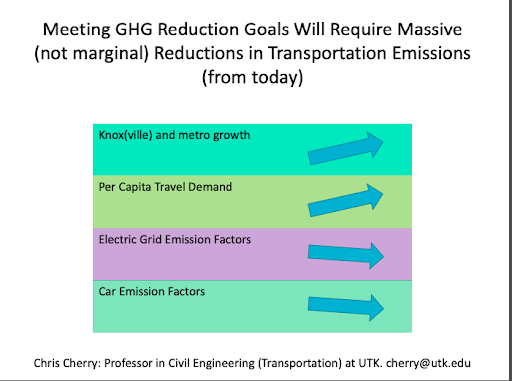
As illustrated by the chart below, low-emission public transit options like buses and trains that are powered by electricity can serve as a silver bullet to this problem. With higher occupancy potential than personal vehicles, the benefits offered by electric mass transit can lead to real reductions in carbon emissions by lowering the number of trips taken in personal vehicles powered by fossil fuels.

Land Use, Zoning, Carbon Emissions
Historically, land uses have been separated by types, with limited connectivity to development, lack of options for transportation, and increased vehicle miles traveled (VMT) as development spread out and made cars more and more necessary. Many developments lack sidewalks, thus making walking a less than feasible option, and while the city of Knoxville does require sidewalks in most new developments, Knox County does not.
One of the solutions to these problems, according to Jeff Welch with Knoxville Regional Transportation Planning Organization, is to prioritize mixed-use development that will allow different forms of transportation.
Belinda Woodiel-Brill with Knoxville Area Transit (KAT) presented on the city’s existing public transit layout. She mentioned that designing transit routes requires a constant balance between maximizing ridership by prioritizing transit services along major streets and maximizing coverage by having buses in more areas that may not have high ridership rates.

Finally, she showed the following slide, reiterating the importance of reducing transportation emissions, as they make up 29% of total US greenhouse gas emissions as of 2017.
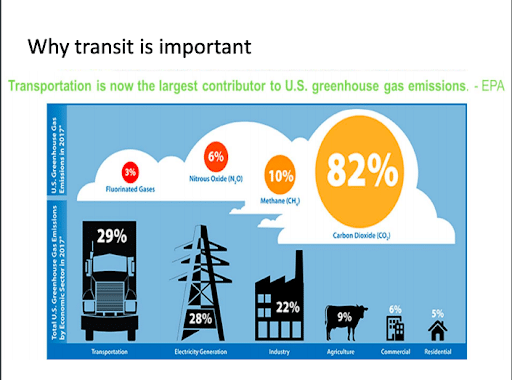
Bicycle and pedestrian travel
Ellen Zavisca with the Knoxville Regional Transportation Planning Organization highlighted the need for increased safety measures for bikers and walkers. The chart below illustrates that a large percentage of pedestrian and bicycle crashes and fatalities occur along with a very small number of major arterial streets; so increasing safety along major streets that make up a small percentage of street mileage could result in vastly improved safety for folks biking and walking, both much less carbon-intensive than other vehicular forms for transportation.
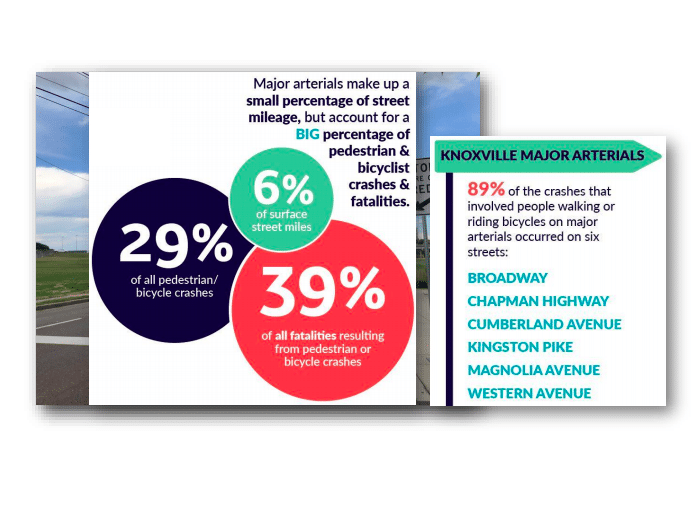
The conversation continued with Caroline Cooley with Bike Walk Knoxville laying out a concept known as “Vision Zero” which has a goal of zero traffic deaths and serious injuries. According to Cooley, achieving “Vision Zero,” will require political commitments from the mayor and city government, followed by the development of a task force to help develop an implementable action plan; equity and engagement with the community; and changes in road design and speed. “Vision Zero” could help achieve fewer greenhouse gas emissions as well: as biking/walking becomes safer, Knoxville will experience increased adoption of those means of transportation and thus less driving.
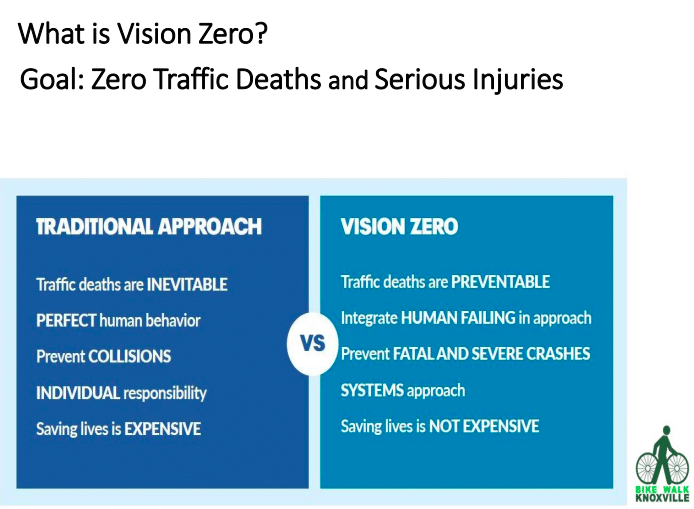
Community Feedback and Strategy Prioritization
Members of the council were asked to rank strategies – the slide below shows the strategies with the highest number of votes in green, including expanded walking and biking infrastructure and investments in public transportation, as well as those with the lowest number of votes in orange.
 Knoxville Mayor Indya Kincannon kicked off the discussion by committing to “Vision Zero” and emphasized the need for safety. She stated people tend to be “change-averse,” and she is looking forward to recommendations from the council. Kincannon also mentioned that getting the politics surrounding these recommendations right will be crucial, as she will need to sell them to the public, and is willing to expend capital and budget to make that happen.
Knoxville Mayor Indya Kincannon kicked off the discussion by committing to “Vision Zero” and emphasized the need for safety. She stated people tend to be “change-averse,” and she is looking forward to recommendations from the council. Kincannon also mentioned that getting the politics surrounding these recommendations right will be crucial, as she will need to sell them to the public, and is willing to expend capital and budget to make that happen. Former City Council member George Wallace harkened back to his time on council and the difficulties, both politically and economically, of getting the Cumberland Avenue project completed. That particular project narrowed the street from four to two lanes and added wider sidewalks. He also said that there are some developments happening in the city that don’t even adhere to the city’s own guidelines regarding building near transit lines.
Ellen Zavisca said that while costs for the Cumberland avenue project were high, there are also a lot of low-cost options, such as more clearly marking intersections with paint, signal timing, and curbs.
Alicia Hemming with Sunrise Knoxville mentioned the need to educate not only the public but car dealers as well on the issue of EVs.
Dr. Stephen Smith, SACE Executive Director, mentioned it would be nice to quantify the carbon reductions associated with each strategy; and Brian Blackmon, Knoxville Sustainability director, said that that would be done and a range of mitigation impacts would be discussed.
Stan Johnson, Socially Equal Energy Efficient Development (SEEED) Executive Director explained his goal of getting this information to low-income community members and making sure the city proceeds in an equitable manner.
Picking up on a point raised by Dr. Smith, David Greene with UTK brought up the point that we have several large auto manufacturers in Tennessee that are building EVs, like Volkswagen and Nissan, but no state incentives for them. He argued that this is a political issue that could be addressed if the large cities in the state, including Knoxville, were to collectively lobby the state government and make the manufacturers want to sell in the state.
Electrifying the South in Knoxville and beyond
SACE has been heavily involved with transportation work throughout the Southeast, especially as it relates to the electrification of the transportation sector. In addition, SACE along with other groups formed the ‘ACT on KUB‘ coalition that advocated for reforms to the city’s public utility, Knoxville Utilities Board (KUB) that sought to bring more accountability, cost-savings, and transparency to KUB. While the charter amendment the group proposed failed, the discussion led to a resolution being passed at a recent City Council meeting that will make important progress on this issue.
We look forward to continuing this work as part of the Climate Council with community partners. The next convening of the Mayor’s Climate Council will occur on August 11 with the transportation working group and will feature a more in-depth technical discussion of possible strategies with transportation experts.
#KnoxvilleClimateCouncil